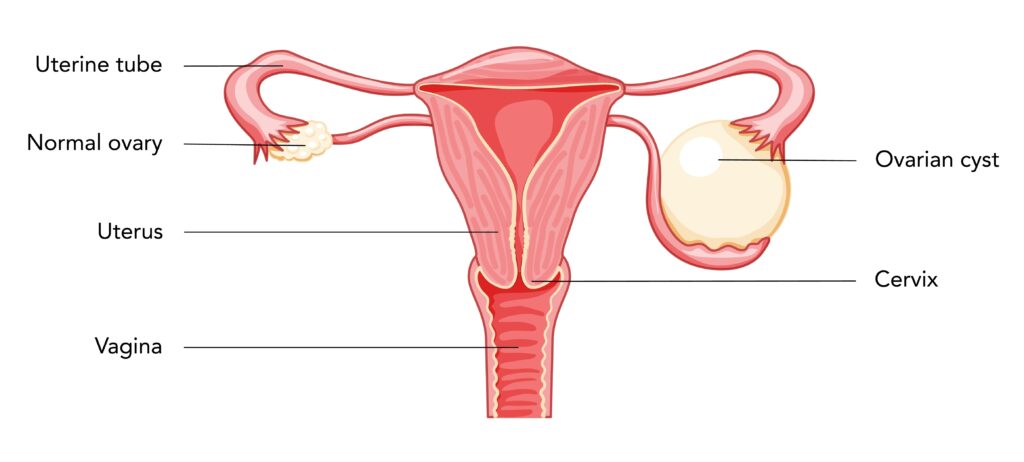Ovarian cysts are a common health condition that many women experience at least once throughout the course of life. Most of these cysts only last a few months, don’t cause discomfort, and really aren’t a problem at all. But sometimes, they can be more troublesome.
What is an Ovarian Cyst?
Before we dig into the details of problematic cysts, it’s important that you’re well versed in the basics of this condition. First things first, you may be wondering—what is an ovarian cyst, anyway? Ovarian cysts are fluid-filled sacs that develop in or on one of a woman’s ovaries (every woman has two ovaries—one on either side of the uterus).
What Causes an Ovarian Cyst?
During a typical menstrual cycle, every woman of reproductive age may develop several small cysts. A cyst is where your eggs grow and it’s where estrogen production occurs. Only 1 or 2 of these cysts will mature, rupture, and produce an egg ready for ovulation. If the small cyst doesn’t ovulate, or heal well after ovulation, a persistent cyst can occur.
Usually, these cysts are small, painless, and don’t even produce symptoms. Many are so asymptomatic that a cyst may develop and resolve itself without a woman even noticing its presence. But sometimes, these cysts can be more problematic—especially when they rupture, cause pain, or exist as a cancerous mass.
When Pelvic Cysts Become a Problem
Here’s a bit more information on the more troublesome varieties of pelvic cysts:
Cystic ovarian mass: Most commonly, these can be cancerous after menopause. To identify conditions like these, it’s very important to visit your gynecologist for pelvic exams each year, or whenever you’re experiencing pain or discomfort that’s out of the ordinary.
Ovarian torsion: This is a condition in which a cyst grows large enough that it causes the ovary to move and twist. It can be particularly problematic if it blocks the blood flow to the ovaries. You may know you’re experiencing ovarian torsion if you suddenly develop serious pelvic pain along with vomiting and nausea.
Ovarian cyst rupture: The larger a cyst grows, the higher the chances of a rupture. When an ovarian cyst ruptures, you may experience internal bleeding and serious amounts of pain, so be sure to see a physician if you’re experiencing intense pelvic pain. Sometimes, vaginal intercourse or other forms of vigorous activity that impact the pelvis can increase the risk of a rupture.
Endometrioma: An endometrioma is a cystic mass brought about by endometriosis, which is a condition where the uterine lining grows outside the uterus. With this condition, the cysts can have a negative impact on a woman’s fertility.

How Fast Do Ovarian Cysts Grow?
Ovarian cyst growth rates vary due to type and individual factors. Most are small and harmless, often unnoticed during childbearing years. However, larger cysts can occur. Consult a Women’s Health Arizona provider or gynecologist for personalized advice based on medical history.
What to Look Out For
As we mentioned earlier, many ovarian cysts don’t produce any signs at all. However, you may experience the following symptoms when an ovarian cyst is present, especially as it grows:
- Painful bowel movements
- Pain during intercourse
- Lower back pain
- Pain in the pelvis before or during your menstrual cycle
- Abdominal bloating
- Nausea or vomiting
When a cyst ruptures, you may experience a few more serious signs, including pain that’s accompanied by fever or vomiting, or sudden and severe pelvic pain. If you are dealing with any of these, seek out medical help as soon as possible to avoid more serious complications.
Treating Ovarian Cysts
Physicians will often choose to monitor a cyst if it isn’t causing any trouble. But when a cyst is growing and growing or doesn’t resolve itself after a few months, your doctor may recommend a treatment to remove the cyst or at least bring it down in size.
Here are a few common treatments you might encounter: Some doctors prescribe birth control pills to prevent new cysts from developing. If a doctor wants to remove a cyst, they may prescribe or perform laparoscopy, which is a minimally invasive surgery that involves just a small incision in the abdomen. In other cases, particularly those involving larger ovarian cysts, a physician may choose to perform laparotomy, which is a more invasive surgical procedure.
If you would like to meet with a knowledgeable doctor, consider contacting Women’s Health Arizona. As Arizona’s largest ObGyn group, we’re trained and solely dedicated to delivering the best ObGyn experience in convenient and comfortable settings around Phoenix.

